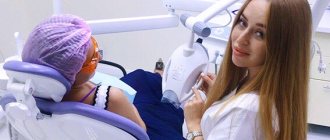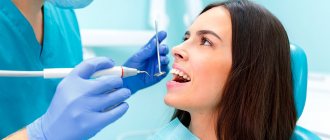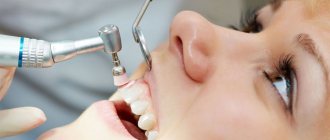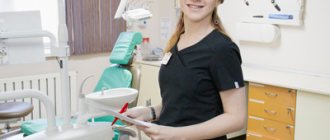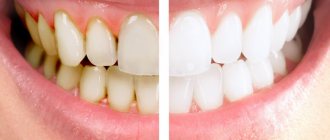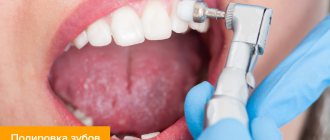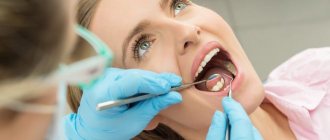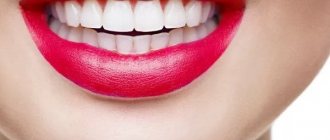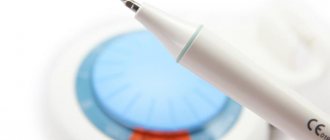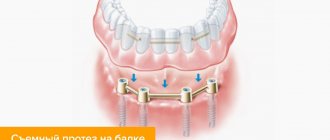Professional oral hygiene is comprehensive care aimed at preventing dental diseases. The technology allows you to get a “brilliant” result in one hour and achieve natural whiteness.
The procedure includes removing plaque using the Air Flow method and cleaning hard plaque with an ultrasonic scaler. At the final stage, fluoridation and remotherapy are performed to strengthen the enamel. In addition, the attending physician teaches the patient about home hygiene and selects care products. Professional care is highly effective, but maintaining the results is only possible if all the dentist’s instructions are followed.
Enamel sensitivity
May increase in the first days after professional hygiene. At first, to avoid pain, it is better not to consume sour or very sweet foods and drinks. It is not recommended to consume cold and hot at the same time or too cold, hot drinks and foods. This is dangerous not only by increasing the sensitivity of the enamel, but also by weakening it and the appearance of microcracks on its surface.
To prevent enamel sensitivity from increasing after professional cleaning, it is better to complete the procedure with remineralization or fluoridation. This will strengthen the enamel and remove discomfort.
If the enamel is weakened, after cleaning, the doctor may additionally prescribe special products, toothpastes, to strengthen it.
If severe pain persists after the procedure or the pain does not decrease within several days, you should consult a dentist.
What can you eat after cleansing?
After the procedure, dentists impose a number of restrictions on the patient’s eating behavior. In the first 2-3 days, foods that irritate tooth enamel are excluded from the diet: sour, hot, salty, sweet. The sensitivity of teeth after ultrasonic cleaning of stone is increased: bright tastes and temperature changes provoke pain.
Products containing dyes are prohibited. The list of what not to eat after brushing your teeth for tartar includes:
- black tea and coffee;
- colored carbonated drinks;
- chocolate;
- soy and balsamic vinegar;
- mustard and curry spices;
- red wine and grapes;
- berries (blueberries, blueberries, currants);
- red and orange vegetables;
- sweets containing dyes.
A number of products are recommended for consumption. They strengthen tooth enamel and prevent the formation of plaque and caries. Dentists advise eating dairy products in any form. Fruits and vegetables, particularly apples, reduce the amount of tartar. It is useful to drink diluted apple juice, which dissolves plaque.
Additional care products
Dental floss, floss. Used to clean interdental spaces. After professional cleaning, use floss carefully so as not to injure the edges of the gums. Movements are directed from the gums to the cutting edge or to the chewing surface of the crown. Floss is used several times a day, as needed (after meals, after morning and evening brushing of teeth).
Irrigator. Using an irrigator helps to maintain the results of professional hygiene for a long time. The device cleans enamel with a thin stream of water under pressure. This type of cleaning removes soft plaque well and prevents the formation of tartar. The irrigator is used once a week or less. It is better if the frequency of such cleanings is determined by a doctor, taking into account the condition of the enamel.
Approximate daily diet
Individual preferences influence what people eat after teeth whitening. A general recommendation would be to not drink alcohol. Wine contains tannins, and beer contains acids. Strong alcohol penetrates through the enamel pores, damaging the integrity of dentin. Therefore, it is better to exclude alcohol from the list of products for a white diet.
Breakfast
(options):
- porridge (with milk, with water);
- omelette;
- banana smoothie;
- buttered toast;
- classic yogurt;
- cottage cheese.
Dinner:
- mushroom soup;
- baked fish;
- potato;
- vegetable soup (avoid dark vegetables);
- poached chicken;
- chicken broth with dumplings.
Dinner:
- sandwich with chicken or cream cheese;
- pasta with white sauce;
- rice with chicken, fish, mushrooms;
- turkey salad;
- white beans;
- cauliflower.
Snacks:
- yogurt;
- baked apple;
- banana;
- cucumber;
- pear;
- white grapes.
By combining products and coming up with something of your own, you can easily survive for 2 weeks without noticing any restrictions.
It is important to ensure that the diet is complete, with a variety of recipes. For the body, the supply of vitamins and nutrients is important. Monotonous food and strict restrictions can lead to intestinal upset, vitamin deficiency, and demineralization of teeth.
On the other hand, you should not panic if you accidentally ate something that is not recommended to eat after whitening. Brush your teeth or rinse your mouth right away, the main thing is not to repeat the mistakes.
Nutrition principles:
- avoid “colored” foods;
- do not drink alcohol;
- to drink a lot of water;
- subject “doubtful products” to heat treatment.
The white diet is not limited to the list of foods that can be eaten after teeth whitening. The dentist will also give other care tips that will strengthen your teeth and prolong the duration of the procedure.
Flaws
Despite these advantages, the procedure has disadvantages:
- when working with the device, it is possible to injure the soft tissues of the oral cavity, so the procedure should only be performed by a highly qualified specialist;
- in some cases it is impossible to remove the stone from all sides;
- For sensitive teeth, local anesthesia will be required.
In addition, ultrasonic teeth cleaning has a number of contraindications.
Note. Sometimes dental clinics use scalers, which, when rotated, can damage tooth enamel. Before you sign up for a procedure, check with the administrator what model of device the dentist will use. If the device is outdated, it is better not to take risks and abandon the procedure.
Can I use dental floss?
If you have any dentures in your mouth, you should either refuse floss completely or use it too carefully. The crowns are fixed in such a way that natural micro-gaps between them are preserved, which require cleansing. However, when flossing, you should not make vertical movements - only horizontal ones. That is, you need to insert the thread not from the cutting edge, gradually moving towards the gums, but place its tip directly into the gap - make several horizontal movements and remove it in a similar way.
Do not use the prosthesis if it has a chip or crack - try to see a doctor as soon as possible to restore the integrity of the crown/inlay or for a prompt replacement. Otherwise, there is a high risk of developing inflammatory processes under the prosthesis.
Professional teeth cleaning
Professional teeth cleaning is a procedure for mechanical or ultrasonic removal of tartar, plaque and pigmentation from the surfaces of teeth, as well as from hard-to-reach areas of the oral cavity. Hygienic cleaning must be done by everyone, without exception, at least 2 times a year.
But this procedure is especially useful and vital for owners of orthodontic structures in the oral cavity, such as implants, braces, and veneers. For those who wear braces, this procedure is very relevant. Since it is not possible to carry out high-quality teeth cleaning at home.
Professional cleaning is also carried out for those who decide to undergo dental treatment or enamel whitening.
Why does tartar appear?
There are many reasons for the deposition of hard plaque, including:
- poor teeth cleaning at home;
- incorrectly selected brush and paste of inadequate quality;
- smoking;
- a large amount of soft food in the diet that does not require thorough chewing;
- dysfunction of the thyroid gland;
- uneven teeth and chewing food on only one side of the jaw.
Removing tartar is much more difficult, and it brings much more problems. In order to avoid possible complications in the future, professional teeth cleaning in dental offices by hygienists will help.
Temperature rises after tooth extraction
A slight increase in general body temperature or local temperature in the area of the operation is considered normal. This is the body's natural reaction to dental surgery.
If the temperature stays within 37-38° C, there is no need to bring it down. If it rises above 38° C, you need to take antipyretic drugs. Avoid using aspirin as it may cause bleeding from the socket.
An increase in temperature over a long period (2 or more days in a row), accompanied by signs of inflammation - severe pain, swelling, swelling of soft tissues, an unpleasant odor from the wound, are direct indications for urgent medical attention.
How smoking affects teeth
Smoking is harmful to the entire body, including the teeth, which are the first to bear the brunt of tobacco smoke and high temperatures. Under the influence of cigarettes, the enamel begins to deteriorate, microcracks appear on it, through which tobacco smoke substances and bacteria present on the teeth quickly penetrate.
Plaque formation in smokers occurs quickly, and it is difficult to remove it on your own. In addition, tobacco lovers are unlikely to brush their teeth after every cigarette they smoke. As a result, the enamel is destroyed, which leads to tooth decay, and the plaque gradually hardens, forming tartar, which contributes to the development of gum disease.
The longer a person smokes, the more their teeth will suffer. Gradually, negative processes will begin to progress, which will undoubtedly entail serious aesthetic and pathological consequences.
How much can you eat after dentures?
After installing permanent crowns or inlays, you can drink water immediately, but eat after 1.5-2 hours. This is not related to the type of prosthesis or the adhesive used for fixation. During treatment, anesthesia is used - and it is very important that its effect wears off completely, otherwise chewing can injure the tongue or the inside of the cheeks.
After installing temporary crowns or inlays, you are allowed to eat food after 2-3 hours. However, in such a situation, it is strongly recommended not to put any stress on the restored tooth and try to chew food on the other side - not only at first, but throughout the entire period of wearing the temporary structure. It is impossible to put a load on such prostheses - they are not designed for it (naturally, if we are talking about crowns or inlays, which are installed for a maximum of 2-3 weeks, and not for a long time).
What hygiene products are needed and can be used?
What hygiene products are needed and can be used?
| NAME | DESCRIPTION |
| Toothbrush | The bristles should be soft or medium hard. Too hard ones can damage the material and leave small scratches on it, in which plaque will accumulate. The use of an ultrasonic or mechanical brush is allowed, but it is very important to carefully select attachments - they should not have plastic elements (often used to better clean or whiten teeth). |
| Toothpaste | It is better to use prophylactic toothpaste WITHOUT abrasive substances - they can damage the materials. |
| Irrigator | It will allow you to remove food debris from the interdental spaces, especially if several crowns are installed in a row or dental bridges are present - in such a situation, a stream of water will remove food debris from under the structure. |
| Mouthwash | It should be selected in accordance with existing oral problems - for example, to combat gum inflammation, to strengthen enamel or to prevent plaque accumulation. That is, regardless of whether you have dentures or not. |
Clinical researches
An analysis of the clinical effectiveness of the use of various therapeutic and prophylactic agents of the Asepta series, carried out in Novosibirsk, at the State Budgetary Educational Institution of Higher Professional Education "Novosibirsk State University", confirmed that the line is different:
- Pronounced hygienic;
- Anti-inflammatory;
- Hemostatic property.
The study examined the effect of the products on the oral health of adolescents, patients with the most sensitive tissues and with pain in wisdom teeth. The use of pastes, balm with propolis and rinse demonstrated an improvement in clinical indicators and confirmed high efficiency in the treatment of periodontal pathology in patients of different ages.
Advantages
Cleansing efficiency.
The ultrasonic system removes tartar with the greatest possible effect without consequences for dental health. In addition, unlike other cleansing methods, ultrasound easily breaks down hard deposits even under the gum. No risk to enamel. Hard stone is difficult to remove mechanically, and it is almost impossible to remove plaque with chemicals without affecting the enamel. Ultrasonic cleaning has no such disadvantages. The system is designed in such a way that it does not directly affect the tooth surface, which significantly reduces the risk of damage.
Whitening effect. After cleaning, many patients who were planning to schedule an appointment for whitening abandon this idea because the teeth become several shades lighter. However, the color of the enamel remains natural, since special bleaching is not performed during the procedure.
Fast and painless. The procedure is painless, does not require special preparation and does not take much time. If the patient has a lot of deposits in the gum line area, the dentist will suggest using topical or local anesthesia with the minimum possible dosage of anesthetic.
Prevention of diseases. As a rule, deposits on teeth can provoke many dental diseases, such as caries, gingivitis or periodontitis. After removing hard deposits and soft plaque, the dentist will be able to correctly assess the condition of the tooth enamel, notice their pathological changes in time and, if necessary, carry out urgent treatment. In addition, ultrasound kills bacteria by delivering an antiseptic solution and the bactericidal effect of cavitation.
Ultrasonic cleaning at the TopSmile clinic
Get an individual consultation with a specialist at the TopSmile clinic
Get acquainted with the service
